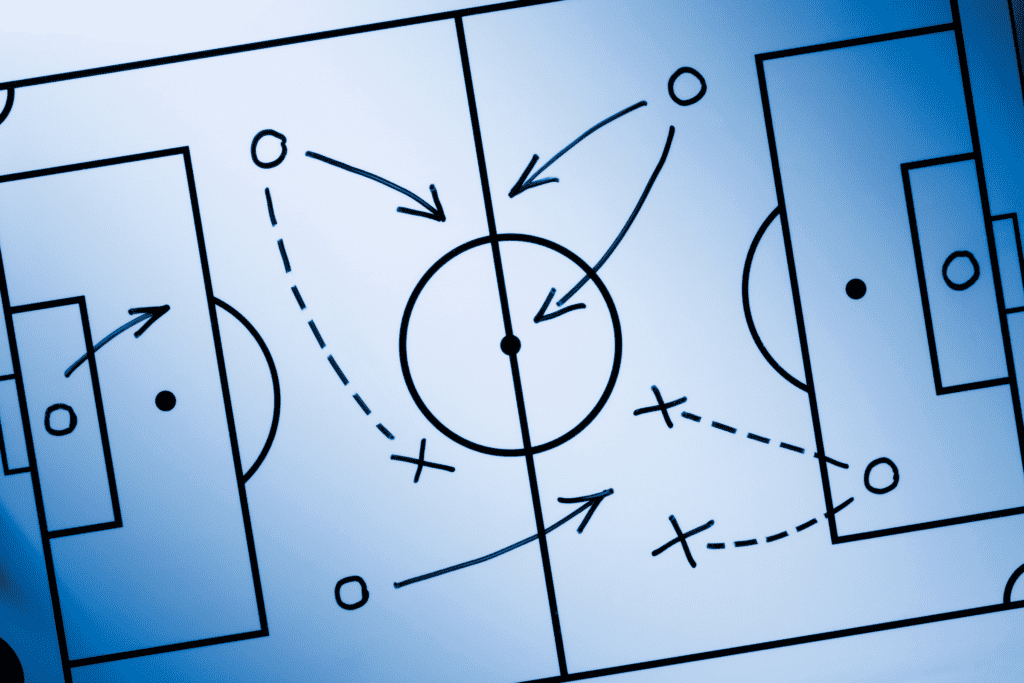Every soccer player should know about tactical soccer training, one of the three types of training. Each is critical for player development, and you should include them in your training regimen.
This article covers the idea of tactical soccer training and why players need to learn more about their team’s strategy, goals, and the game of soccer.
Tactical soccer training develops team strategy and tactics and improves players’ soccer awareness and intelligence. It’s different from technical and physical training because it does not require a ball or physical activity. Tactical training is generally done as a team, whereas technical and physical training can be done together or individually.
The three types of soccer training develop different abilities; you should train your body and brain across these training sessions to become a complete soccer player.
Keep reading to learn more about tactical soccer training and how you can use it as a player or coach for team and individual development.
Table of Contents
What is tactical soccer training?
Soccer players must train in multiple skills to improve, including their fitness, technical skills, and tactics. Although essential to players individually, tactical training involves learning team strategy led by the coaching staff.
Tactical soccer training focuses on a team’s overall strategy. Team formation, when to press the ball on defense, and where players should be when your team has the ball are discussed during these sessions. They do not involve on-the-ball drills and focus solely on the team’s tactics.
Tactical training can feel dull and monotonous, but it’s critical for player and team development. Understanding and rehearsing tactics is vital for a team’s success.

Tactical soccer training revolves around the team’s goals on the field (not the physical goals in that you shoot the ball). A team’s plan could be prioritizing defense at the start of the game to keep a clean sheet in the first half. On the other hand, a team’s goal could be to equal the game and press high up the field when you’re down by a point.
These are the things that coaches and players will discuss and practice during a tactical training session. In this case, film is a valuable tool.
Film sessions are a type of tactical training session you can do with your team or yourself. Watching film is a great way to learn from mistakes and pinpoint when and where to make adjustments to the team’s overall strategy.
Team strategy in soccer
Strategizing for soccer is about making a plan for games and executing that plan when the time comes. Team strategy is discussed during tactical soccer training, but what does that mean, and what is a good soccer strategy?
Soccer strategy depends on your team’s formation and how you want to play the game. Aggressive formations like the 4-3-3 are offensive formations that create goal-scoring opportunities. Formations like the 5-3-2 prioritize defense and controlling your third of the field. The strategy incorporates tactics based on your team’s style of play.
Soccer strategy and tactics are important. Without them, teams struggle to score goals and defend properly. These topics discussed during tactical training sessions should be top of mind for players and coaches, especially before a game.
Teams lacking a distinct strategy are easy for other teams to break down and figure out. Investing in learning an overall strategy is key to winning a lot of games.
Additionally, and perhaps most importantly, it helps players think more about the game of soccer and all of its inner workings.

Tactical training vs. technical training
Tactical training trains our brains to become better soccer players. These practices improve our soccer awareness and intelligence and help develop the team’s strategy.
Tactical training differs from technical training because tactical sessions don’t require a soccer ball or involve drills or scrimmages. Tactical training sessions focus on developing a team’s strategy, whereas technical training develops players’ skills at the individual level.
Tactical training is essential for player and team development. Coaches should incorporate some form of tactical training into a soccer team’s training regimen to ensure everyone is on the same page during games.
These types of training aren’t necessary to do weekly but should occur at least once every other week in some fashion. Either gather your team during a technical training session and discuss tactics for a few minutes, or host a film session where you watch an old game or another team’s game footage.
Tactical training vs. physical training
Tactical training is different from physical training. While neither requires a soccer ball, tactical training does not require any running. Some tactical training sessions use movement, but it’s often only used to demonstrate tactics.
Physical training in soccer increases fitness levels. These training sessions incorporate conditioning and agility drills, usually without a soccer ball. Physical training for soccer means getting into game shape and preparing players to perform at high intensity.
This differs from tactical training in that tactical training does not require some movement. They’re the same in that they can include a soccer ball, but it’s not necessary.
Using a soccer ball during these sessions is a way to make them more enjoyable for younger players. Additionally, it helps players visualize strategies and tactics as if they were happening during a game.
| Tactical | Physical | Technical |
|---|---|---|
| Develop a greater understanding of the sport | Increase overall fitness levels | Develop skills (dribbling, shooting, passing, ball control, etc.) |
| Discuss team-oriented strategy and tactics | Can incorporate soccer balls to simulate game-like scenarios | Become a better all-around player |
| Review past game films to address mistakes and bad habits | Shorter; can be added onto the end of another type of training | Build chemistry with teammates |
